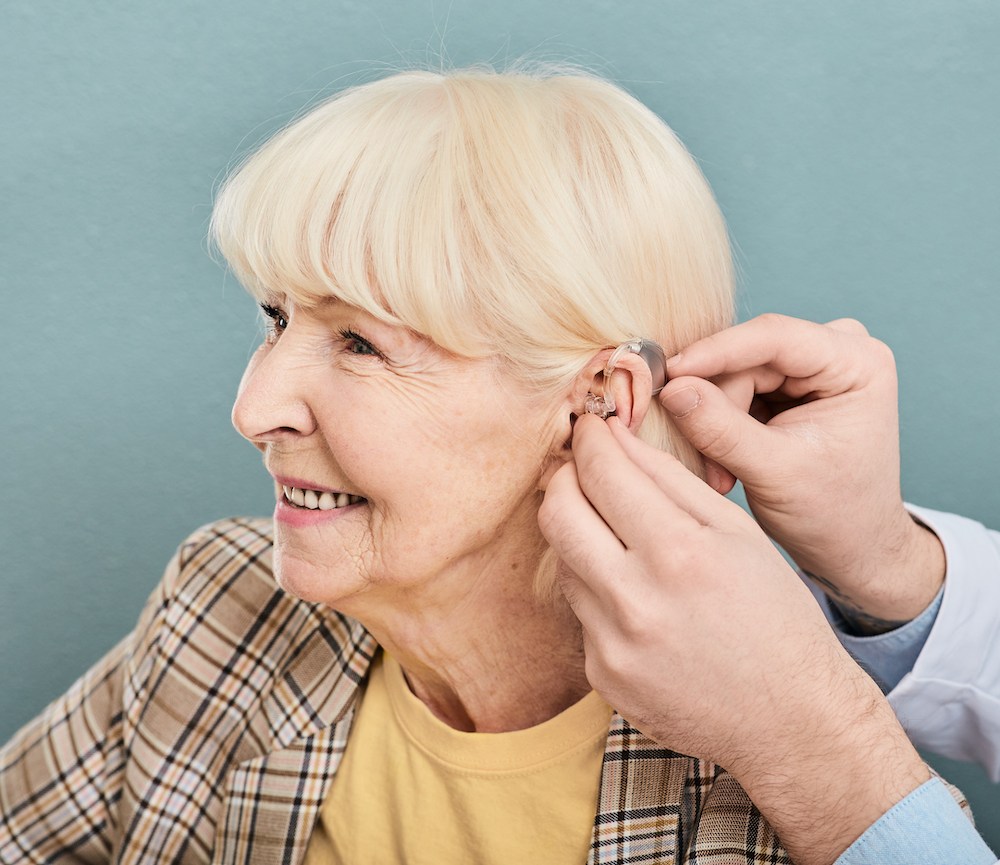The Role of Hearing Aids in Virtual Meetings
Virtual meetings have become a regular part of how we work and stay

By: admin | February 18, 2025
Remember that whistling sound from older hearing aids? It used to be one of the most common complaints about hearing devices – that high-pitched squeal that would happen at the worst moments. Today’s hearing aids have come a long way, especially when it comes to managing feedback. This annoying whistling isn’t just uncomfortable – it can make you feel self-conscious and even tempted to remove your hearing aids.
Modern feedback cancelation systems work behind the scenes to stop these sounds before they start, letting you focus on the conversations and activities that matter. Whether you’re hugging a loved one, talking on the phone or wearing a hat, your hearing aids should work without drawing attention to themselves. The technology has improved so much that many people forget they’re even wearing hearing aids.
Hearing aids capture sound, amplify it and then deliver the louder sound into the ear, helping to improve clarity and volume for the user. They consist of three main components working together: a microphone, which picks up sounds from the surrounding environment and converts them into electrical signals; an amplifier, which processes and increases the volume of these signals to the appropriate level; and a speaker, which delivers the amplified sound into the ear. This process happens almost instantly, allowing users to hear sounds more clearly in real time.
Most hearing aids also incorporate advanced technology, like feedback cancelation to reduce whistling noises and noise reduction to help filter out unwanted background sounds, improving overall sound quality and making it easier to focus on speech and important environmental cues. But remember, not all hearing aids are the same. There’s a wide variety of models available, each with its own set of features designed to address different types of hearing loss and lifestyle needs. Factors like size, style, features and how well it fits with your lifestyle are important to consider when choosing a hearing aid.
The functionality of a hearing aid revolves around transforming ambient noise into clear, understandable sound. The microphone captures the sounds around you, converting them into digital signals. This process is akin to taking a sonic snapshot of your environment.
These digital signals are then processed by the hearing aid’s internal computer, or its ‘brain’. This ‘brain’ adjusts the signals based on your specific hearing loss and listening needs – amplifying some frequencies while reducing others.
These adjusted signals are then converted back into sound waves and delivered to your ears through tiny speakers. The result? Conversations, music and more are heard with greater clarity and understanding.
Let’s shift our focus from the technicalities of how a hearing aid functions to a specific feature: feedback in hearing aids. This essential aspect significantly contributes to your overall hearing experience.
Feedback in hearing aids refers to the whistling noise you might hear when sound that has been amplified by the device escapes and re-enters the microphone. The hearing aid interprets this as a new sound and amplifies it again, creating a loop that results in an annoying whistle. However, modern devices are equipped with advanced technology designed to cancel this feedback:
Transitioning from feedback cancelation, let’s examine why whistling noises occur in hearing aids. This whistling sound, also known as feedback, happens when amplified sound escapes from your ear and re-enters the hearing aid microphone. The device then re-amplifies this sound, creating a loop that results in an unwanted whistle.
Several factors can contribute to this issue. One common reason is a poor fit of the hearing aid or earmold in your ear canal. If the device doesn’t fit snugly, amplified sound can leak out and create a feedback loop. Other reasons could include excessive earwax build-up or damage to the hearing aid itself. Understanding these causes can help you prevent and manage this annoying occurrence effectively.
Feedback cancelation technology is designed to detect and eliminate feedback, or that whistling sound you might hear from your hearing aid. It does this by identifying the specific frequency of the feedback and then creating an opposite sound wave to cancel it out. Imagine two waves crashing into each other in the ocean – they neutralize each other, right? That’s exactly what this technology does with sound waves.
This smart system works automatically, constantly monitoring for potential feedback so you can enjoy conversations and activities without any irritating interruptions. By reducing feedback, it also allows for greater amplification of sounds you want to hear, improving overall communication and sound quality.
When you’re engaged in conversation, enjoying your favorite music or simply going about your day, an unexpected high-pitched whistle can be distracting and frustrating. Feedback cancelation works automatically in the background, detecting and eliminating these unwanted sounds before they become noticeable. By preventing interference and maintaining a smooth listening experience, this technology ensures that amplified sound remains clear and natural. Instead of dealing with disruptions, you can focus on the voices, music and everyday sounds that matter most, making interactions and listening experiences more enjoyable and effortless.
It operates seamlessly behind the scenes, allowing you to enjoy clear and crisp sound without any interruptions. This means that your focus remains where it should be – on the important sounds and conversations around you. By reducing feedback, this technology enables greater amplification of essential sounds.
Feedback cancellation is particularly valuable in environments where sounds are amplified or where hearing aids are more likely to pick up unwanted interference. One common setting where this feature is crucial is in social gatherings or crowded spaces. In these environments, background noise and multiple sound sources can make it difficult to focus on a single conversation. The constant movement and fluctuating sounds can sometimes cause hearing aids to experience feedback, especially if the device is not seated properly in the ear.
Another environment where feedback cancellation is essential is during phone calls or media streaming. Whether you’re taking a call on your smartphone or listening to your favorite music or podcast, the sound needs to be amplified and transmitted clearly. Hearing aids without feedback cancellation can produce irritating noises or distortions, especially when audio is coming directly into the device.
Quiet, intimate settings like one-on-one conversations in a calm room can also benefit from feedback cancellation. While these environments may have less ambient noise, they may still cause feedback if the hearing aid microphone picks up sound from the ear canal and reflects it back into the system.
Feedback cancelation improves sound quality by eliminating the high-pitched whistling that can occur with hearing aids. This whistling, known as feedback, often results from amplified sound escaping the ear canal and being reprocessed by the hearing aid’s microphone. Without feedback cancelation, this interference can be distracting and disruptive, making it harder to focus on speech or other important sounds.
Beyond improving sound clarity, feedback cancelation also enhances overall comfort for the user. Without this feature, individuals may find themselves frequently adjusting their hearing aids or lowering the volume to avoid whistling, which can reduce the effectiveness of amplification. With feedback cancelation working automatically in the background, users can wear their hearing aids with confidence, knowing that they will receive consistent sound without needing to make constant manual adjustments.
Another key benefit of feedback cancelation is its ability to improve social interactions and communication. When feedback occurs during conversations, it can be distracting not only for the user but also for those around them. By preventing these interruptions, feedback cancelation helps maintain the natural flow of conversations, making it easier to engage with others without worrying about unwanted noise.
Modern hearing aids offer a range of advanced features designed to improve sound quality, comfort and overall listening experience. One key feature is noise reduction, which helps filter out background noise, making it easier to focus on speech in busy environments like restaurants or crowded gatherings. This technology continuously analyzes incoming sounds and distinguishes between speech and unwanted noise, reducing distractions and improving clarity. Some models also offer adaptive noise reduction, which automatically adjusts based on the surrounding environment for a more seamless listening experience.
Another important feature is directional microphones, which enhance speech understanding by focusing on sounds coming from a specific direction while minimizing noise from other areas. This is especially beneficial in conversations, as it allows users to hear the person speaking to them more clearly, even in noisy settings. Many hearing aids now include multiple microphone settings, enabling users to switch between different modes depending on their surroundings. Some even have automatic directionality, which detects and adjusts to the source of speech without the need for manual adjustments.
Wireless connectivity is another feature that significantly enhances the listening experience. Many modern hearing aids can connect directly to smartphones, televisions and other audio devices via Bluetooth, allowing users to stream calls, music and media directly into their hearing aids. This not only provides better sound quality but also reduces background noise interference, creating a more immersive and enjoyable listening experience. Additionally, some hearing aids are compatible with remote controls or smartphone apps, giving users the ability to adjust settings, change volume or switch between programs with ease.
Not only does feedback technology enhance overall sound quality, but it also allows for greater amplification of the sounds you want to hear, thereby improving overall communication. This makes your day-to-day life more enjoyable and fulfilling by allowing you to fully participate in conversations and activities without unnecessary distractions or discomfort.
If you still have questions or need professional advice on choosing the right hearing aid that best fits your lifestyle and needs, don’t hesitate to reach out to our team at Advanced Hearing of Brighton. You can contact us at our Howell, MI office by calling (810) 355-2245 for more information. Our team is ready and eager to help you find the solutions that will integrate easily into your everyday activities!
Tags: benefits of hearing aids, hearing aid repair, hearing aid styles

Virtual meetings have become a regular part of how we work and stay
By: admin | October 20, 2025

A beach vacation sounds relaxing until you start thinking about your
By: admin | July 29, 2025

Music is part of most people’s daily routines, whether you listen
By: admin | June 20, 2025
